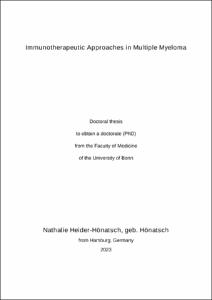Heider-Hönatsch, Nathalie: Immunotherapeutic Approaches in Multiple Myeloma. - Bonn, 2023. - Dissertation, Rheinische Friedrich-Wilhelms-Universität Bonn.
Online-Ausgabe in bonndoc: https://nbn-resolving.org/urn:nbn:de:hbz:5-73499
Online-Ausgabe in bonndoc: https://nbn-resolving.org/urn:nbn:de:hbz:5-73499
@phdthesis{handle:20.500.11811/11173,
urn: https://nbn-resolving.org/urn:nbn:de:hbz:5-73499,
author = {{Nathalie Heider-Hönatsch}},
title = {Immunotherapeutic Approaches in Multiple Myeloma},
school = {Rheinische Friedrich-Wilhelms-Universität Bonn},
year = 2023,
month = dec,
note = {Checkpoint inhibition (CPI) has shown dramatic improvements in overall survival in many malignant diseases. However, in multiple myeloma (MM) the results were disappointing resulting in an early termination of clinical trials. Despite the advantages in therapy the disease remains incurable.
Aim of this work was to seek the possibilities of CPI in MM and evaluate its efficiency and immunological mechanisms with focus on PD-1/PD-L1 signaling. To do so, we used KaLwRij mice that develop MM upon injection of 5T33 myeloma cells. Bone marrow, lymph nodes and spleen cells were analyzed by flow cytometry for the phenotype of immune cells. Mice were either treated with combined CPI or with mAbs blocking PD-1 and panobinostat to evaluate a potential synergistic therapeutic effect.
Our results showed that comprehensive immunophenotyping including the analysis of T and NK cell subpopulations revealed no differences between early disease stage MM bearing mice and healthy control groups. Treatment of mice by blocking the PD-1/PD-L1 signaling pathway alone had no effect on tumor growth and survival.
As it was demonstrated that HDAC inhibitors beside their direct effect on malignant cells may increase the immunogenicity of malignant cells by improving the presentation of tumor antigens and modulate the immunological composition of the tumor microenvironment (TME), we questioned whether a synergistic therapeutic effect might be achieved by combining HDAC inhibition with CPI.
We found that the pan-HDAC inhibitor panobinostat that is approved for the treatment of myeloma patients inhibited the development of myeloma in treated mice. Surprisingly, the combined application of the anti-PD-1 blocking antibody with panobinostat reduced the anti-myeloma effect of the compound and resulted in decreased survival.
To analyze the role of PD-L1 expression on myeloma cells in tumor progression and in the cross talk with the immune microenvironment, we generated a PD-L1 KO of the 5T33 cell line using the CRISPR/Cas9 technology.
We found no differences in the expression of surface molecules such as MHC class I and II, co-stimulatory or adhesion molecules, proliferation and migration of the genetically engineered cells in comparison to the mock control. Interestingly, mice inoculated with the 5T33 PD-L1 KO cells showed a significant longer survival compared with the 5T33 mock injected, indicating that blocking of the PD-L1 molecule on myeloma cells plays an important role in the pathogenesis of MM and its direct blocking on malignant cells rather than in the TME might have an impact on the clinical efficiency.},
url = {https://hdl.handle.net/20.500.11811/11173}
}
urn: https://nbn-resolving.org/urn:nbn:de:hbz:5-73499,
author = {{Nathalie Heider-Hönatsch}},
title = {Immunotherapeutic Approaches in Multiple Myeloma},
school = {Rheinische Friedrich-Wilhelms-Universität Bonn},
year = 2023,
month = dec,
note = {Checkpoint inhibition (CPI) has shown dramatic improvements in overall survival in many malignant diseases. However, in multiple myeloma (MM) the results were disappointing resulting in an early termination of clinical trials. Despite the advantages in therapy the disease remains incurable.
Aim of this work was to seek the possibilities of CPI in MM and evaluate its efficiency and immunological mechanisms with focus on PD-1/PD-L1 signaling. To do so, we used KaLwRij mice that develop MM upon injection of 5T33 myeloma cells. Bone marrow, lymph nodes and spleen cells were analyzed by flow cytometry for the phenotype of immune cells. Mice were either treated with combined CPI or with mAbs blocking PD-1 and panobinostat to evaluate a potential synergistic therapeutic effect.
Our results showed that comprehensive immunophenotyping including the analysis of T and NK cell subpopulations revealed no differences between early disease stage MM bearing mice and healthy control groups. Treatment of mice by blocking the PD-1/PD-L1 signaling pathway alone had no effect on tumor growth and survival.
As it was demonstrated that HDAC inhibitors beside their direct effect on malignant cells may increase the immunogenicity of malignant cells by improving the presentation of tumor antigens and modulate the immunological composition of the tumor microenvironment (TME), we questioned whether a synergistic therapeutic effect might be achieved by combining HDAC inhibition with CPI.
We found that the pan-HDAC inhibitor panobinostat that is approved for the treatment of myeloma patients inhibited the development of myeloma in treated mice. Surprisingly, the combined application of the anti-PD-1 blocking antibody with panobinostat reduced the anti-myeloma effect of the compound and resulted in decreased survival.
To analyze the role of PD-L1 expression on myeloma cells in tumor progression and in the cross talk with the immune microenvironment, we generated a PD-L1 KO of the 5T33 cell line using the CRISPR/Cas9 technology.
We found no differences in the expression of surface molecules such as MHC class I and II, co-stimulatory or adhesion molecules, proliferation and migration of the genetically engineered cells in comparison to the mock control. Interestingly, mice inoculated with the 5T33 PD-L1 KO cells showed a significant longer survival compared with the 5T33 mock injected, indicating that blocking of the PD-L1 molecule on myeloma cells plays an important role in the pathogenesis of MM and its direct blocking on malignant cells rather than in the TME might have an impact on the clinical efficiency.},
url = {https://hdl.handle.net/20.500.11811/11173}
}






